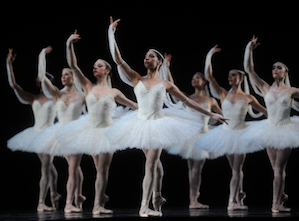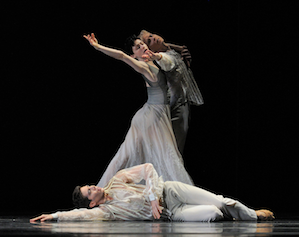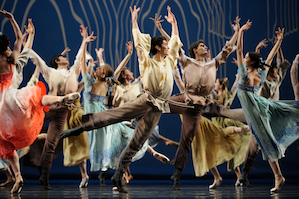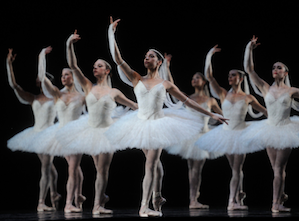
Photos by Erik Tomasson
Two dozen ballerinas step down an invisible ramp, floating through the dark. They pause in arabesque, their white tutus and bridal veils glowing with light. They repeat the phrase, over and over and over; watching, we are at once soothed and awed. The women are the Shades, multiple, identical images of the temple dancer Nikiya (Yuan Yuan Tan) conjured up in an opium dream by the warrior Solor (Davit Karapetyan), who loves her. We’re watching a meditation, a tribute to an art form, and arguably the most gorgeous passage in classical ballet.
With that second act of La Bayadère, staged by Natalia Makarova in 1974 after Marius Petipa — the music is by Ludwig Minkus; the conductor was Martin West — the San Francisco Ballet launched its second mixed bill of the season, a tasty buffet that also included Christopher Wheeldon’s Ghosts (2010) and Yuri Possokhov’s Firebird (2007). Karapetyan was everything a danseur noble should be, with high and perfect leaps, wonderful bounding turns, beautiful pointed feet, and an elegance and strength that have grown in the past year. He and the exquisite Tan were perfectly matched. Her power and knifelike extensions are cloaked in refinement and purity. Nothing feels rushed, not even the tricky moment when she rolls onto his shoulder for a lift that floats her across the stage. Added depth was provided by the Shades trio of Mathilde Froustey, Simone Messmer and Frances Chung, each a distinct dynamic.

Makarova, who took a bow Friday night, dedicated the current performances to the memory of her husband, San Francisco industrialist Edward Karkar, who died last December. Bayadère is based on her memory of dancing in it at the Kirov (now Maryinsky) Ballet; her full-length version is in the repertory of American Ballet Theatre. The richness of Act 2 made this onlooker wish Artistic Director Helgi Tomasson would ask Makarova to bring on the rest of it.
Wheeldon’s Ghosts, a nighttime fantasy set to music by C.F. Kip Winger, holds interest throughout; when it comes to dancers in groups, the choreographer is a master manipulator. The cast (a dozen corps, five principals) is in jammies, they lie on the floor a lot, and there’s a huge dark metal mobile designed by Laura Jellinek in the foreground that sometimes descends and at the end uncurls a bit as if it might come crashing down. The contrast of the pajamas and the often sexy intertwining of the dancers, plus that Big Scary Thing make the ballet teeter between sophistication and childishness. Not that it matters much when you can watch Sofiane Sylve move so declaratively and compellingly. No nightmares for her, it would seem, though she may have set some up in her ménage with Tiit Helimets and Shane Wuerthner, persistently tilting and reframing the balance. Maria Kochetkova and Vitor Luiz provided the stunning counterweight in close and sensitive partnership.

Helimets becomes a prince in the next ballet, Firebird, which choreographer in residence Possokhov peopled with tasty characters and accented with the folklore of his Russian homeland. Building on Michel Fokine’s 1910 ballet for Diaghilev’s Ballet Russe, set to the Igor Stravinsky score, Possokhov creates an orange Firebird (Sarah Van Patten); an evil wizard, Kastchei (Pascal Molat), with a fake nose and nasty fingernails; and a sweet Princess (Sasha de Sola), golden-haired to match the Prince. And there’s a giant egg that’s practically another character, since it contains all the evils of the world, soon, no worries, to be vanquished. Yuri Zhukov did the sets, which include trees with golden fruit, Russian-style churches, and an orange orb that complements the Firebird’s uh, coloring. The costumes are Sara Woodall’s.
Nobody takes anything very seriously here; the evil is cartoony, the Firebird’s rescue is to be expected, and the egg with fire instead of yolk is a fabulous visual, as is the sweet final moment when the captive villagers go free and the Firebird, heartbroken that the prince has fallen in love with another, signals her forgiveness by sending a single, floating feather to the happy couple’s nuptials.
Before that, we have a rather boring pas de deux for Prince and Firebird, delightful folk-infused dancing for the Princess and her little friends, and a funny moment when they jump up and down to shake the fruit from its tree. Molat’s Kastchei, however, contributes a sense of genuine menace, leaping and gesturing like the devil.

